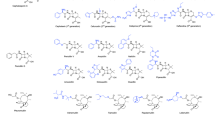Abstract
The origin of the Saccharomyces cerevisiae strains that are responsible for spontaneous grape must fermentation was investigated in a long-established industrial winery by means of two different approaches. First, seven selected components of the analytical profiles of the wines produced by 58 strains of S. cerevisiae isolated from different sites and phases of the production cycle of a Grechetto wine were subjected to Principal Components Analysis. Secondly, the same S. cerevisiae isolates underwent PCR fingerprinting by means of δ primers. The results obtained by both methods demonstrate unequivocally that under real vinification conditions, the S. cerevisiae strains colonising the winery surfaces are the ones that carry out the natural must fermentation.
Similar content being viewed by others
References
Ciani M. 1998. Wine vinegar production using base wines made with different yeast species. J. Sci. Food Agric. 78: 290-294.
Ciani M. and Maccarelli F. 1998. Oenological properties of non-Saccharomyces yeasts associated with wine-making. World J. Microb. Biot. 14: 199-203.
Ciani M., Maccarelli F., Martini A. and Vettorello G. 1997. Selezione di starter di vinificazione autoctoni della D.O.C. autoprosecco di Conegliano-Valdobbiadene. L'Enotecnico 10: 81-88.
Costantì M., Poblet M., Arola L., Mas A. and Guillarmon J.M. 1997. Analysis of yeast population during alcoholic fermentation in a newly established winery. Am. J. Enol. Vitic. 48: 339-344.
Egli C.M., Edinger W.D., Mitrakul C.M. and Henick-Kling T. 1998. Dynamics of indigenous and inoculated yeast populations and their effect on the sensory character of Riesling and Chardonnay wines. J. Appl. Microbiol. 85: 779-789.
Fernández-Espinar M.T., López V., Ramón D., Bartra E. and Querol A. 2001. Study of the authenticity of commercial wine yeast strains by molecular techniques. Int. J. Food Microbiol. 70: 1-10.
Guerra E., Sordi G., Mannazzu I., Clementi F. and Fatichenti F. 1999. Occurrence of wine yeasts on grapes subjected to different pesticide treatments. Ital. J. Food Sci. 3: 221-230.
Kurtzman C.P. and Fell J. 1998. In: Kurtzman C.P. and Fell J.W. (eds), The Yeast, A Taxonomic Study. Elsevier Press, Amsterdam.
Martini A. 1993. Origin and domestication of the wine yeast Saccharomyces cerevisiae. J. Wine Res. 4: 165-176.
Martini A., Ciani M. and Scorzetti G. 1996. Direct enumeration of and isolation of wine yeasts from grape surfaces. Am. J. Enol. Vitic. 47: 435-440.
Mortimer R. and Polsinelli M. 1999. On the origins of wine yeast. Res. Microbiol. 150: 199-204.
Ness F., Lavallée F., Dubordieu D., Aigle M. and Dulau L. 1993. Identification of yeast strains using the polymerase chain reaction. J. Sci. Food Agric. 62: 89-94.
Phaff H.J., Miller M.W. and Mrak E. 1978. In: The Life of Yeasts. Cambridge University Press, Cambridge, MA.
Rosini G., Federici F. and Martini A. 1982. Yeast flora of grape berries during ripening. Microbiol. Ecol. 8: 83-89.
Rosini G. 1984. Assessment of dominance of added yeast in wine fermentation and origin of Saccharomyces cerevisiae in wine-making. J. Gen. Appl. Microbiol. 30: 249-256.
Rosini G., Ciani M. and Vaughan-Martini A. 1988. Vino Sagrantino D.O.C.: Correlazione tra le colture di Saccharomyces cerevisiae isolate dai vini e quelle presenti nei locali di vinificazione. Ann. Microbiol. 38: 171-179.
Török T., Mortimer R.K., Romano P., Suzzi G. and Polsinelli M. 1996. Quest for wine yeasts-an old story revisited. J. Ind. Microbiol. 17: 303-313.
Vaughan-Martini A. and Martini A. 1995. Facts, myths and legends on the prime industrial microorganism. J. Ind. Microbiol. 14: 514-522.
Vaughan Martini A. and Martini A. 1998. Saccharomyces Meyen ex Rees. In: Kurtzman C.P. and Fell J.W. (eds), The Yeast, A Taxonomic Study. Elsevier Press, Amsterdam, pp. 358-371.
Author information
Authors and Affiliations
Rights and permissions
About this article
Cite this article
Ciani, M., Mannazzu, I., Marinangeli, P. et al. Contribution of winery-resident Saccharomyces cerevisiae strains to spontaneous grape must fermentation. Antonie Van Leeuwenhoek 85, 159–164 (2004). https://doi.org/10.1023/B:ANTO.0000020284.05802.d7
Issue Date:
DOI: https://doi.org/10.1023/B:ANTO.0000020284.05802.d7




